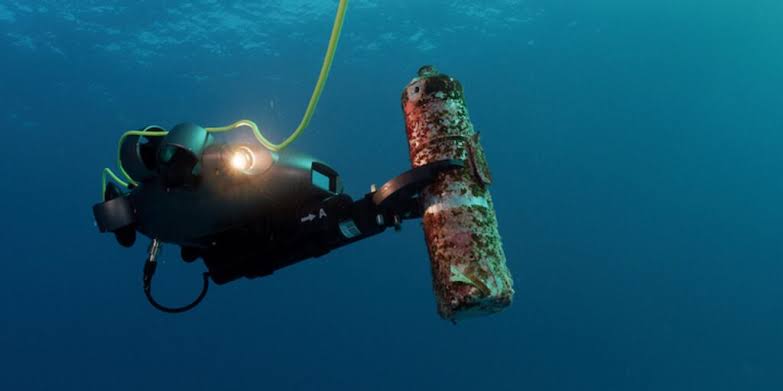
Underwater Drones: The Next Big Thing in Adventure Gadgets
Underwater drones are revolutionizing aquatic exploration by making deep-sea adventures accessible to all. From capturing coral reefs in stunning 4K to aiding marine research, these high-tech gadgets blend thrill with utility. Whether you’re a diver, content creator, or nature enthusiast, they offer a safe and exciting way to explore underwater worlds. With rapid advancements in features and affordability, underwater drones are emerging as must-have tools in the next wave of adventure tech.
✨ Raghav Jain

Introduction
In the world of adventure tech, underwater drones are making serious waves—quite literally. Once limited to military or industrial use, these high-tech gadgets are now available to explorers, divers, filmmakers, and even hobbyists. With the ability to dive deep, record 4K videos, and send live feeds back to your device, underwater drones are becoming the must-have gadget for water lovers and tech enthusiasts alike.
From coral reef exploration to underwater treasure hunts, these devices are revolutionizing how we interact with the world beneath the surface. Compact, smart, and thrilling—they are the next big thing in adventure technology.
In this article, we’ll dive into what underwater drones are, how they work, why they’re trending, and how you can use them to unlock a whole new world of aquatic adventure. Underwater drones, also known as Remotely Operated Vehicles (ROVs) or Autonomous Underwater Vehicles (AUVs), are rapidly emerging as the next big thing in adventure gadgets, transforming how enthusiasts explore the mysteries beneath the waves. No longer confined to the realms of professional marine research, industrial inspection, or military applications, these submersible marvels are becoming increasingly accessible and sophisticated for personal recreational use. They offer an unprecedented gateway to the underwater world, allowing individuals to witness marine life, explore shipwrecks, inspect underwater structures, and even participate in search and recovery efforts, all from the safety and comfort of the surface.
The appeal of underwater drones for adventure lies in their ability to provide an immersive and often high-definition view of aquatic environments without the need for specialized diving skills or expensive equipment like scuba gear. Equipped with advanced cameras, often capable of capturing stunning 4K UHD video and high-resolution stills, powerful LED lights to illuminate the darkest depths, and sometimes even sonar systems for navigation in murky waters, these gadgets open up a world previously reserved for professional divers and researchers. Imagine effortlessly piloting a drone through a vibrant coral reef, observing exotic fish in their natural habitat, or meticulously documenting a sunken artifact, all while streaming live footage to your smartphone or tablet. This democratizes underwater exploration, making it accessible to a broader audience, from amateur naturalists and photographers to avid boaters and curious hobbyists.
Technological advancements have been pivotal in this shift. Modern adventure-grade underwater drones boast features that were once the exclusive domain of commercial or scientific ROVs. These include impressive depth capabilities, with some models reaching hundreds of meters, extended battery life for prolonged exploration sessions, and enhanced maneuverability thanks to multi-thruster designs offering six degrees of freedom. Many also incorporate intelligent functionalities like auto-depth holding, posture lock, and even obstacle avoidance, making them remarkably user-friendly even for beginners. The integration of virtual reality (VR) headsets further elevates the experience, providing a truly immersive first-person perspective as if you were personally swimming alongside your drone. Furthermore, the advent of modular designs allows users to attach various accessories, such as robotic arms for collecting samples, water quality sensors, or even bait drops for fishing, expanding their utility beyond mere observation.
For adventure seekers, the applications are diverse and thrilling. Underwater photography and videography are perhaps the most popular uses, allowing users to capture breathtaking footage of marine biodiversity, document unique underwater landscapes, and create compelling content for social media or personal archives. Boaters can utilize them to inspect their hulls, propellers, or anchor lines without having to get into the water. Anglers can employ drones with fish finders to locate schools of fish and even observe their behavior. For those with a historical bent, underwater drones can be invaluable tools for exploring shipwrecks and submerged historical sites, providing a safer and less intrusive alternative to human diving. They also hold immense potential for personal search and recovery missions, helping to locate lost items in lakes, rivers, or coastal waters.
Beyond individual pursuits, the growing popularity of underwater drones is also impacting marine tourism and conservation. Tour operators are beginning to integrate these devices into their offerings, providing guests with unique perspectives of marine ecosystems from the comfort of a boat. On the conservation front, hobbyists and citizen scientists can contribute valuable data by recording observations of marine life, monitoring coral reef health, or identifying pollution, thereby supporting broader scientific initiatives.
However, with this burgeoning popularity come important considerations. While generally safer than human diving, responsible operation is paramount. Users should be mindful of local regulations regarding drone use in specific aquatic areas, respect marine life by maintaining a safe distance, and avoid operating in environmentally sensitive zones where disturbance could occur. Understanding the drone's capabilities and limitations, especially concerning depth, battery life, and current resistance, is crucial to prevent loss or damage.
Looking ahead, the future of recreational underwater drones appears exceptionally bright. We can anticipate even greater levels of autonomy with advancements in AI and machine learning, allowing drones to navigate more complex environments and identify objects with greater precision. Improvements in underwater communication technologies will enable longer ranges and more robust data transmission. Furthermore, the trend towards miniaturization and increased portability will make these gadgets even more convenient for adventurers on the go. As costs continue to decrease and capabilities expand, underwater drones are poised to become an indispensable tool for anyone seeking to explore, document, and connect with the mesmerizing world beneath the surface, truly cementing their status as the next big thing in adventure gadgets.
What Are Underwater Drones?
Underwater drones, also called ROVs (Remotely Operated Vehicles) or UUVs (Unmanned Underwater Vehicles), are robotic devices designed to function below the water’s surface. They can be tethered (connected by cable) or wireless, and are operated remotely through a controller or smartphone app.
Key features include:
- High-resolution cameras (up to 4K)
- LED lighting for deep or dark waters
- GPS and sonar systems
- Propellers for smooth, multi-directional movement
- Depth range from 10 meters to 100+ meters
They’re used for recreation, research, photography, marine rescue, and exploration—and are gaining popularity with vloggers, travel influencers, and ocean lovers.
Why Underwater Drones Are Trending
- Adventure Meets Innovation
- People want to capture more than just aerial views—now it's about underwater secrets. Drones help users film shipwrecks, coral reefs, or fish in their natural habitat.
- Eco-Tourism Growth
- With rising interest in marine biodiversity and reef conservation, underwater exploration is more than just fun—it’s meaningful.
- Compact and User-Friendly
- Modern drones are lightweight, portable, and easy for beginners to use—making them perfect for vacations or beach trips.
- Social Media Buzz
- Unique underwater content is a hit on platforms like Instagram, YouTube, and TikTok. Drones offer cinematic-quality footage.
- Tech Advancements
- Better battery life, clearer imaging, and AI features (like object tracking) make these drones more accessible and powerful.
Types of Underwater Drones
- Tethered Drones
- Connected to a cable
- Reliable live streaming
- Great for deep dives and steady exploration
- Wireless Drones
- Controlled via WiFi/Bluetooth
- More freedom of movement
- Ideal for shallow, recreational use
- Fishing Drones
- Equipped with sonar or bait-release systems
- Help find fish locations
- Popular among sports fishers
- Professional Cinematic Drones
- Stabilized 4K or 8K video
- Dual camera systems
- Used in documentaries or oceanic studies
Top Features to Look For
- Camera Quality: 1080p to 4K+ for clear visuals
- Depth Capability: Choose based on where you’ll explore (30m for beginners, 100m+ for pros)
- Battery Life: Ranges from 1 to 4 hours
- Stabilization & Lighting: Gyroscope and LED systems for smooth, lit footage
- Control Range: Distance from which you can operate the drone (30–200 meters)
- Storage & Streaming: SD cards, cloud sync, or live-view apps
- Durability: Waterproof rating (IP68 or higher), saltwater resistance
Creative Uses of Underwater Drones
- Travel Vlogging & Adventure Filming
- Capture coral reefs, shipwrecks, and rare marine species in cinematic angles.
- Scuba Diving Support
- Pre-scan diving spots or monitor divers during dives for safety.
- Marine Education Projects
- Perfect for students, researchers, and documentaries about ocean life.
- Fishing & Underwater Surveys
- Track fish movement or scan the seabed before casting a line.
- Treasure Hunting & Sunken Exploration
- Explore old wrecks, sunken boats, or ancient ruins safely and easily.
Daily Tips for Using Underwater Drones
Before You Dive:
- Fully charge the battery
- Check propellers and waterproof seals
- Download footage from last use to free up space
During Use:
- Avoid strong currents and heavy waves
- Keep the drone within visual or signal range
- Use sonar to avoid rocks or obstacles
After Use:
- Rinse drone with freshwater (especially after saltwater use)
- Dry thoroughly before storage
- Update firmware regularly via app
Best Locations to Use Your Underwater Drone
- Beaches with clear waters (Goa, Maldives, Andamans)
- Lakes and rivers (check legal use in freshwater bodies)
- Diving spots with coral reefs
- Harbors and docks (for ship exploration)
- Swimming pools (great for testing and training)
Safety & Legal Guidelines
- Always follow local marine and drone laws
- Avoid disturbing marine life or protected reef zones
- Use only in calm, visible water conditions
- Don’t leave drone submerged beyond its depth/time limit
- Do not fly near boats, divers, or fishing zones without permission
Sample Weekly Adventure Plan With Underwater Drones
DayActivityMondayResearch a local water body with good visibilityTuesdayTest drone in swimming pool or calm lakeWednesdayRecord reef or seabed visuals for contentThursdayEdit and upload underwater clips or photosFridayPractice object-tracking or depth testsSaturdayTake it on a beach trip or diving adventureSundayClean, charge, and review footage
Common Myths About Underwater Drones: Busted!
“They’re too expensive.”
→ Not anymore! Entry-level models start around ₹20,000–₹30,000 with good camera quality.
“Only professionals can use them.”
→ Wrong! Many drones are beginner-friendly with app-based controls.
“Saltwater ruins them instantly.”
→ False! Just rinse with freshwater after use. Most models are made for both freshwater and saltwater.
“You can’t see anything underwater.”
→ With LED lights, high-res cameras, and clean water—you can capture amazing visuals.
“Underwater drones are too fragile.”
→ Modern builds are rugged, shockproof, and built to handle ocean environments.
Top 5 Popular Underwater Drones in the Market (2025)
- CHASING Dory – Compact, beginner-friendly, smartphone-controlled
- Geneinno Titan – Deep diving up to 150 meters, 4K footage
- PowerVision PowerRay – Fishing features, VR compatibility
- FIFISH V6 Expert – 360° movement, pro-level video
- Gladius Mini S – Great balance of price and performance
Sample Setup for an Underwater Drone Adventure
Before Trip
- Charge drone, controller, and phone
- Carry extra batteries and propellers
- Store drone in waterproof case
At Location
- Scan area for water clarity
- Tether drone (if needed)
- Start with shallow test run
Post-Adventure
- Download footage
- Clean and dry drone
- Post highlights on social media or vlog
Conclusion
Underwater drones are more than just cool gadgets—they’re a portal to a hidden world beneath the surface. Whether you're an adventurer, vlogger, hobbyist, or diver, these high-tech tools offer an entirely new way to explore and capture the mysteries of the deep.
With ever-improving technology and growing affordability, now is the best time to add an underwater drone to your collection. From coral gardens to sunken treasures, every dive becomes a story waiting to be told.
Dive into innovation. Explore the deep. Capture the unseen.
Because the real adventure begins where the land ends.
Q&A Section
Q1:- What are underwater drones and how do they work?
Ans :- Underwater drones, also called ROVs (Remotely Operated Vehicles), are robotic devices equipped with cameras and sensors. They’re controlled via remote or apps and navigate underwater using propellers, collecting visuals and data in real time.
Q2:- Why are underwater drones becoming popular in adventure tourism?
Ans :- They offer explorers a way to dive deep into oceans, lakes, and rivers without physically diving, capturing breathtaking footage of marine life, shipwrecks, and coral reefs—enhancing thrill-seeking with safety and ease.
Q3:- How do underwater drones help amateur and professional divers?
Ans :- These gadgets scout dive spots, inspect underwater conditions, and record dives from unique angles—making them useful for training, safety assessments, and capturing epic underwater memories.
Q4:- What are some exciting features in modern underwater drones?
Ans :- High-res 4K cameras, LED lighting, GPS tracking, sonar, depth ratings up to 100 meters or more, and live-streaming capabilities make them powerful and user-friendly even for non-experts.
Q5:- Are underwater drones only used for fun?
Ans :- No. They're widely used in marine research, underwater inspections (ships, pipelines), search and rescue missions, and environmental monitoring—making them versatile beyond just adventure.
Q6:- How affordable are underwater drones for regular consumers?
Ans :- Prices range from ₹30,000 to ₹3,00,000+, depending on features. While some high-end models are expensive, many entry-level drones are becoming accessible to hobbyists and travelers.
Q7:- How can underwater drones enhance vlogging and content creation?
Ans :- They allow creators to shoot rare, cinematic underwater scenes—from coral reefs to marine creatures—boosting the uniqueness and engagement of their travel or nature content.
Q8:- What safety measures should be taken while using underwater drones?
Ans :- Users should follow local marine regulations, avoid disturbing wildlife, maintain visual contact where possible, and ensure proper battery sealing to prevent water damage.
Q9:- What are the limitations of current underwater drones?
Ans :- Battery life, limited range, signal interference underwater, and mobility in rough currents are some current challenges manufacturers are trying to overcome with innovation.
Q10:- What is the future of underwater drones in the adventure tech space?
Ans :- With AI, longer battery life, autonomous navigation, and better imaging, future underwater drones will likely become smarter, more compact, and an essential part of water-based exploration gear.
Similar Articles
Find more relatable content in similar Articles

The Role of AI Facial Recognit..
AI facial recognition is revo.. Read More

Hyperloop Technology: A Game-..
Hyperloop technology envision.. Read More

Top AI Applications for Design..
AI is revolutionizing social .. Read More

How Wearable Devices Detect Hu..
Wearable devices use biosenso.. Read More
Explore Other Categories
Explore many different categories of articles ranging from Gadgets to Security
Smart Devices, Gear & Innovations
Discover in-depth reviews, hands-on experiences, and expert insights on the newest gadgets—from smartphones to smartwatches, headphones, wearables, and everything in between. Stay ahead with the latest in tech gear
Apps That Power Your World
Explore essential mobile and desktop applications across all platforms. From productivity boosters to creative tools, we cover updates, recommendations, and how-tos to make your digital life easier and more efficient.
Tomorrow's Technology, Today's Insights
Dive into the world of emerging technologies, AI breakthroughs, space tech, robotics, and innovations shaping the future. Stay informed on what's next in the evolution of science and technology.
Protecting You in a Digital Age
Learn how to secure your data, protect your privacy, and understand the latest in online threats. We break down complex cybersecurity topics into practical advice for everyday users and professionals alike.
© 2025 Copyrights by rTechnology. All Rights Reserved.